Innovation and Entrepreneurship: Point-of-Care Testing in Australia
VerifiedAdded on 2021/04/21
|16
|4167
|22
Report
AI Summary
This report provides an in-depth analysis of innovation and entrepreneurship within the Australian Medical Technologies and Pharmaceutical industry, with a specific focus on Point-of-Care Testing (PoCT). The executive summary highlights the importance of combining innovation and entrepreneurship, examining how PoCT has enhanced healthcare delivery. The report details the value proposition of PoCT, its target market, and its competitors, using a qualitative research method based on Australian websites. It explores the business model, value capture strategies, and recommendations for future innovations, such as virtual reality medical services. The findings reveal that PoCT offers convenience and cost savings for patients, leading to improved patient care and satisfaction. The report also discusses the importance of knowledge and capability development for sustaining innovation and competitiveness within the medical technology sector.
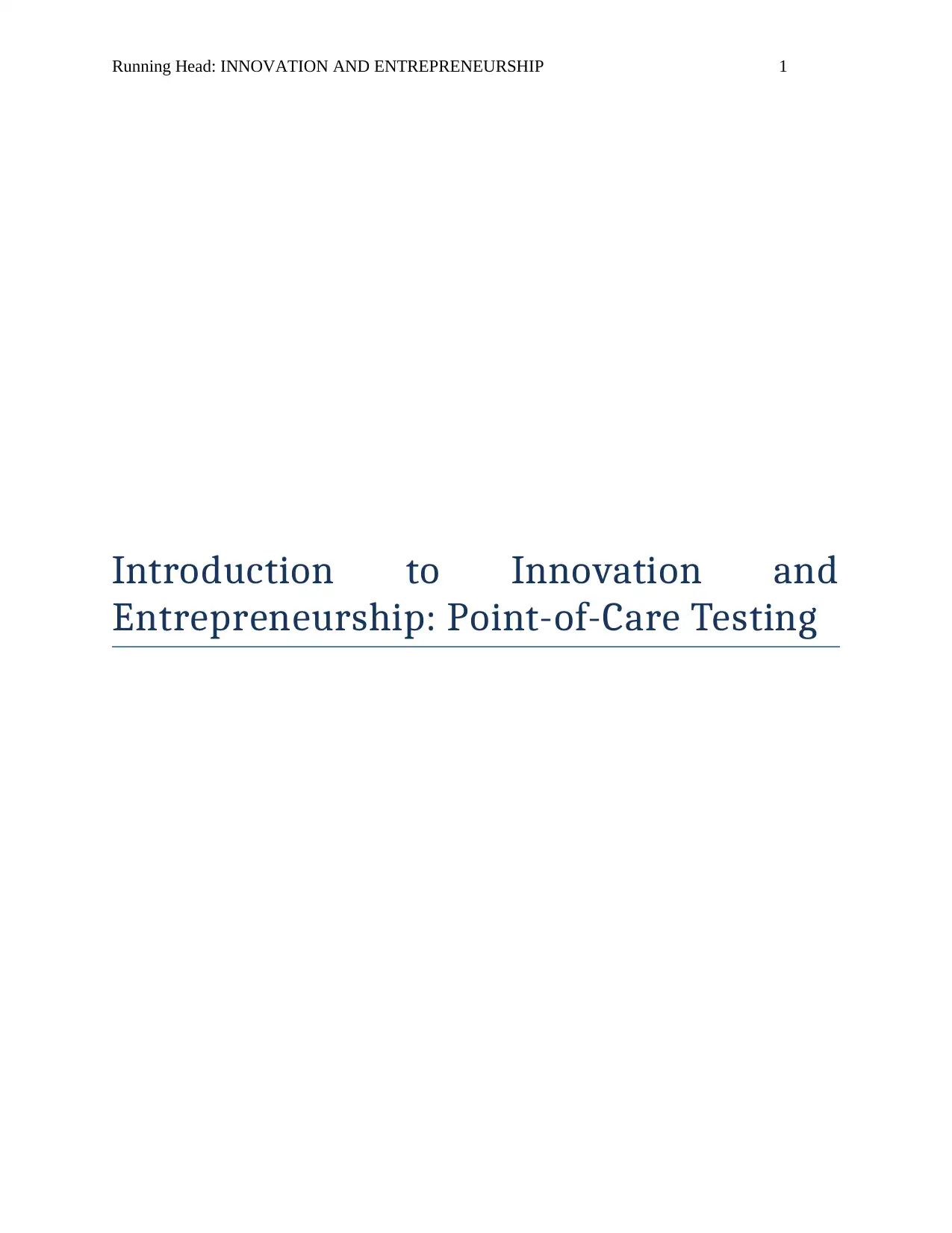
Running Head: INNOVATION AND ENTREPRENEURSHIP 1
Introduction to Innovation and
Entrepreneurship: Point-of-Care Testing
Introduction to Innovation and
Entrepreneurship: Point-of-Care Testing
Paraphrase This Document
Need a fresh take? Get an instant paraphrase of this document with our AI Paraphraser
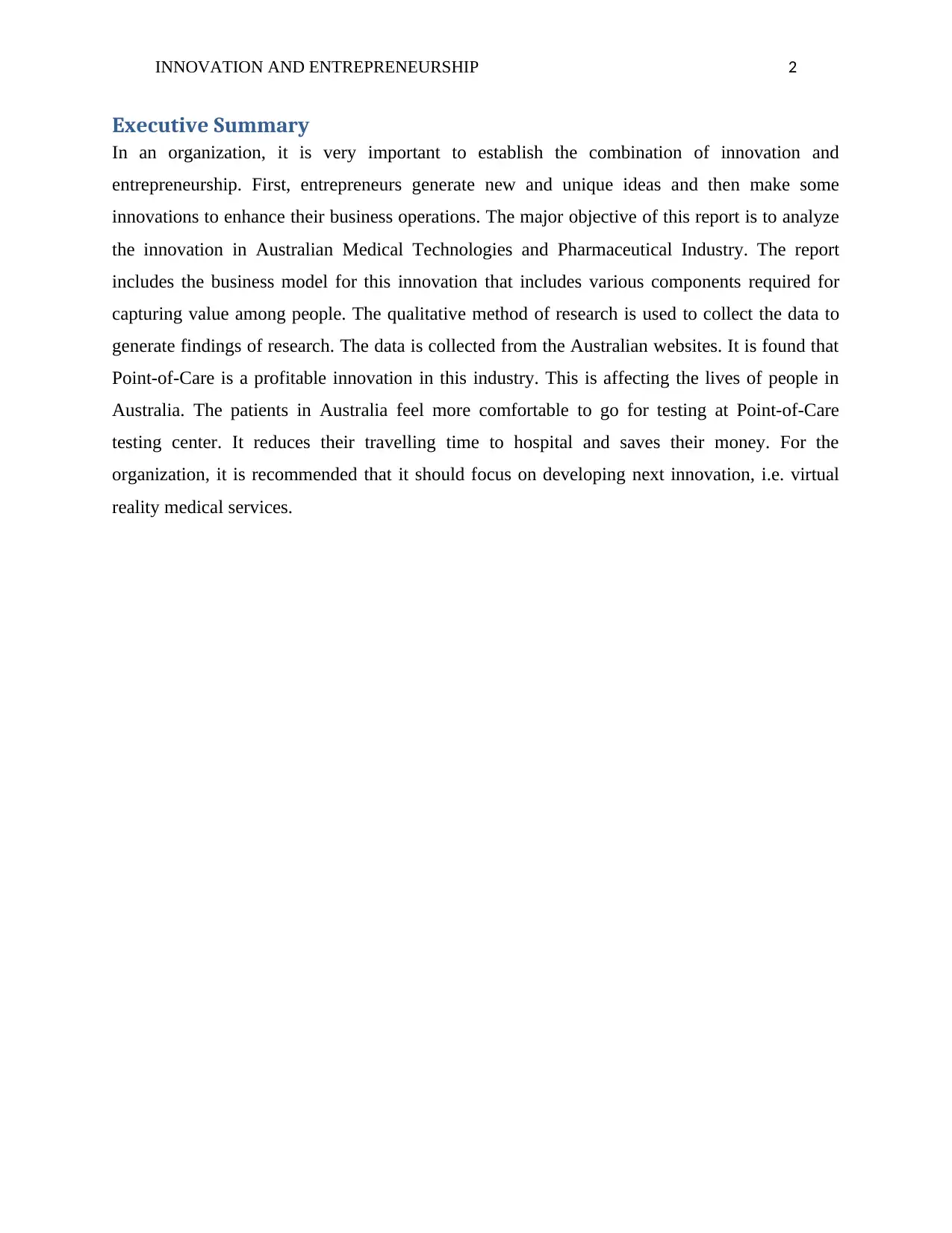
INNOVATION AND ENTREPRENEURSHIP 2
Executive Summary
In an organization, it is very important to establish the combination of innovation and
entrepreneurship. First, entrepreneurs generate new and unique ideas and then make some
innovations to enhance their business operations. The major objective of this report is to analyze
the innovation in Australian Medical Technologies and Pharmaceutical Industry. The report
includes the business model for this innovation that includes various components required for
capturing value among people. The qualitative method of research is used to collect the data to
generate findings of research. The data is collected from the Australian websites. It is found that
Point-of-Care is a profitable innovation in this industry. This is affecting the lives of people in
Australia. The patients in Australia feel more comfortable to go for testing at Point-of-Care
testing center. It reduces their travelling time to hospital and saves their money. For the
organization, it is recommended that it should focus on developing next innovation, i.e. virtual
reality medical services.
Executive Summary
In an organization, it is very important to establish the combination of innovation and
entrepreneurship. First, entrepreneurs generate new and unique ideas and then make some
innovations to enhance their business operations. The major objective of this report is to analyze
the innovation in Australian Medical Technologies and Pharmaceutical Industry. The report
includes the business model for this innovation that includes various components required for
capturing value among people. The qualitative method of research is used to collect the data to
generate findings of research. The data is collected from the Australian websites. It is found that
Point-of-Care is a profitable innovation in this industry. This is affecting the lives of people in
Australia. The patients in Australia feel more comfortable to go for testing at Point-of-Care
testing center. It reduces their travelling time to hospital and saves their money. For the
organization, it is recommended that it should focus on developing next innovation, i.e. virtual
reality medical services.
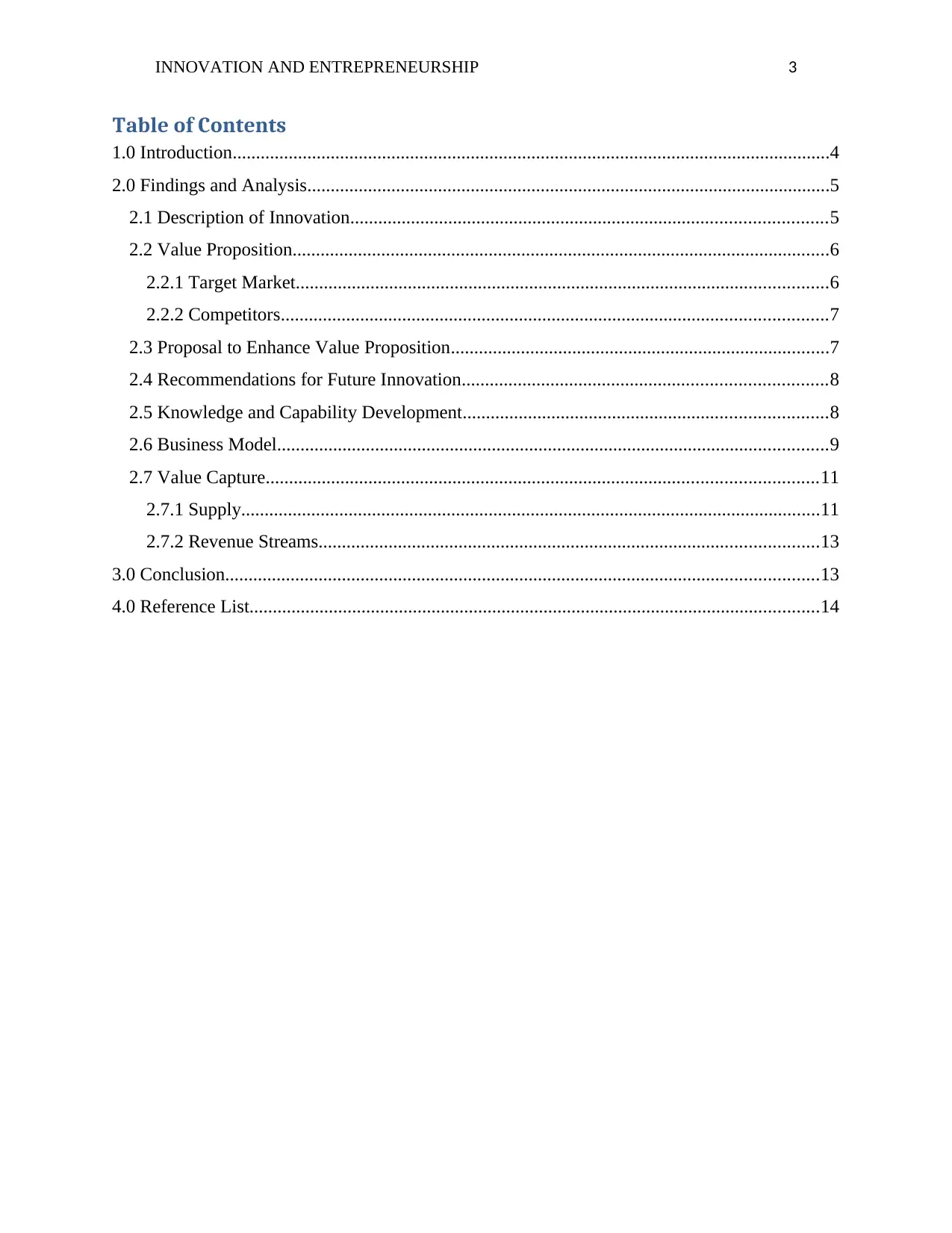
INNOVATION AND ENTREPRENEURSHIP 3
Table of Contents
1.0 Introduction................................................................................................................................4
2.0 Findings and Analysis................................................................................................................5
2.1 Description of Innovation......................................................................................................5
2.2 Value Proposition...................................................................................................................6
2.2.1 Target Market..................................................................................................................6
2.2.2 Competitors.....................................................................................................................7
2.3 Proposal to Enhance Value Proposition.................................................................................7
2.4 Recommendations for Future Innovation..............................................................................8
2.5 Knowledge and Capability Development..............................................................................8
2.6 Business Model......................................................................................................................9
2.7 Value Capture......................................................................................................................11
2.7.1 Supply............................................................................................................................11
2.7.2 Revenue Streams...........................................................................................................13
3.0 Conclusion...............................................................................................................................13
4.0 Reference List..........................................................................................................................14
Table of Contents
1.0 Introduction................................................................................................................................4
2.0 Findings and Analysis................................................................................................................5
2.1 Description of Innovation......................................................................................................5
2.2 Value Proposition...................................................................................................................6
2.2.1 Target Market..................................................................................................................6
2.2.2 Competitors.....................................................................................................................7
2.3 Proposal to Enhance Value Proposition.................................................................................7
2.4 Recommendations for Future Innovation..............................................................................8
2.5 Knowledge and Capability Development..............................................................................8
2.6 Business Model......................................................................................................................9
2.7 Value Capture......................................................................................................................11
2.7.1 Supply............................................................................................................................11
2.7.2 Revenue Streams...........................................................................................................13
3.0 Conclusion...............................................................................................................................13
4.0 Reference List..........................................................................................................................14
⊘ This is a preview!⊘
Do you want full access?
Subscribe today to unlock all pages.

Trusted by 1+ million students worldwide
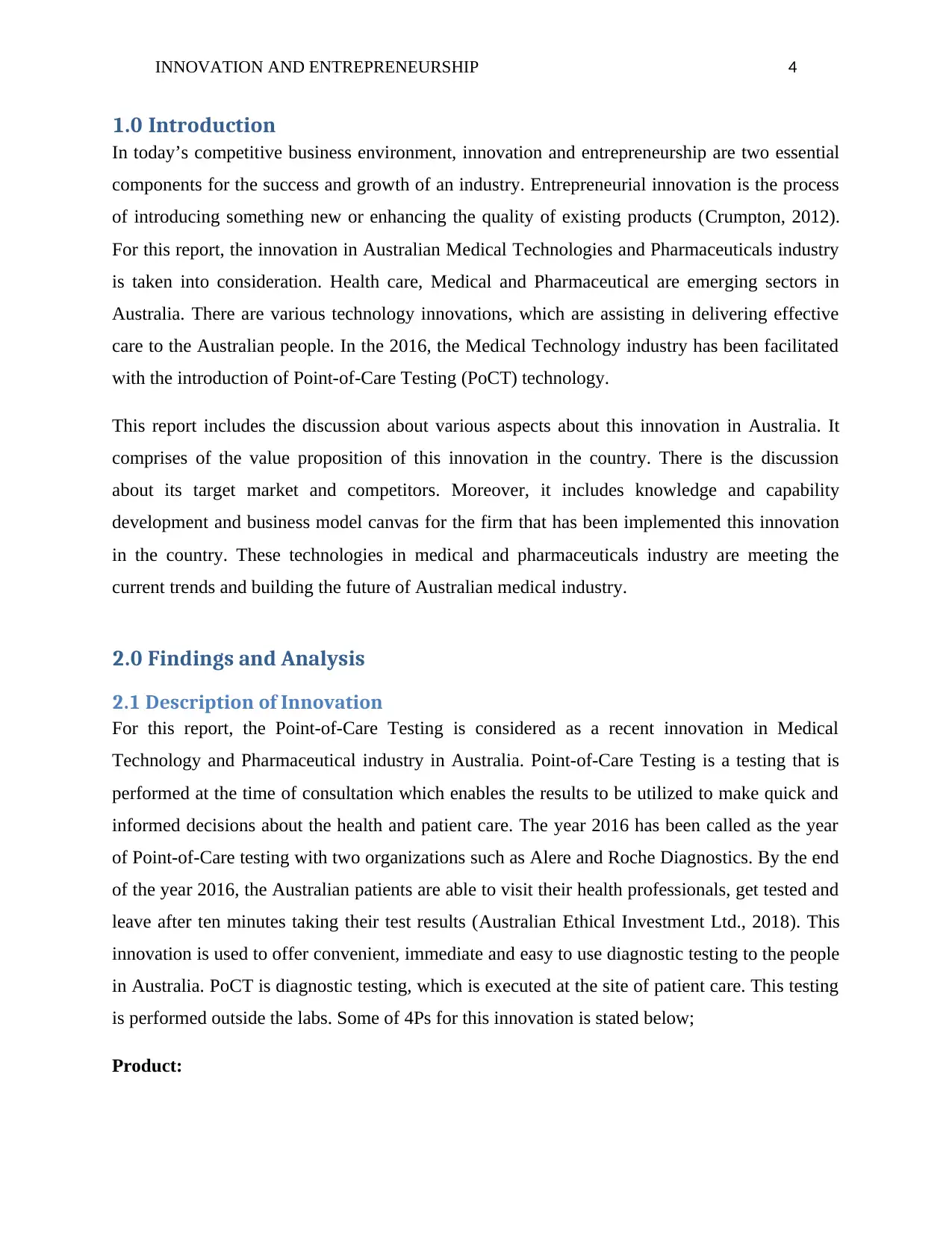
INNOVATION AND ENTREPRENEURSHIP 4
1.0 Introduction
In today’s competitive business environment, innovation and entrepreneurship are two essential
components for the success and growth of an industry. Entrepreneurial innovation is the process
of introducing something new or enhancing the quality of existing products (Crumpton, 2012).
For this report, the innovation in Australian Medical Technologies and Pharmaceuticals industry
is taken into consideration. Health care, Medical and Pharmaceutical are emerging sectors in
Australia. There are various technology innovations, which are assisting in delivering effective
care to the Australian people. In the 2016, the Medical Technology industry has been facilitated
with the introduction of Point-of-Care Testing (PoCT) technology.
This report includes the discussion about various aspects about this innovation in Australia. It
comprises of the value proposition of this innovation in the country. There is the discussion
about its target market and competitors. Moreover, it includes knowledge and capability
development and business model canvas for the firm that has been implemented this innovation
in the country. These technologies in medical and pharmaceuticals industry are meeting the
current trends and building the future of Australian medical industry.
2.0 Findings and Analysis
2.1 Description of Innovation
For this report, the Point-of-Care Testing is considered as a recent innovation in Medical
Technology and Pharmaceutical industry in Australia. Point-of-Care Testing is a testing that is
performed at the time of consultation which enables the results to be utilized to make quick and
informed decisions about the health and patient care. The year 2016 has been called as the year
of Point-of-Care testing with two organizations such as Alere and Roche Diagnostics. By the end
of the year 2016, the Australian patients are able to visit their health professionals, get tested and
leave after ten minutes taking their test results (Australian Ethical Investment Ltd., 2018). This
innovation is used to offer convenient, immediate and easy to use diagnostic testing to the people
in Australia. PoCT is diagnostic testing, which is executed at the site of patient care. This testing
is performed outside the labs. Some of 4Ps for this innovation is stated below;
Product:
1.0 Introduction
In today’s competitive business environment, innovation and entrepreneurship are two essential
components for the success and growth of an industry. Entrepreneurial innovation is the process
of introducing something new or enhancing the quality of existing products (Crumpton, 2012).
For this report, the innovation in Australian Medical Technologies and Pharmaceuticals industry
is taken into consideration. Health care, Medical and Pharmaceutical are emerging sectors in
Australia. There are various technology innovations, which are assisting in delivering effective
care to the Australian people. In the 2016, the Medical Technology industry has been facilitated
with the introduction of Point-of-Care Testing (PoCT) technology.
This report includes the discussion about various aspects about this innovation in Australia. It
comprises of the value proposition of this innovation in the country. There is the discussion
about its target market and competitors. Moreover, it includes knowledge and capability
development and business model canvas for the firm that has been implemented this innovation
in the country. These technologies in medical and pharmaceuticals industry are meeting the
current trends and building the future of Australian medical industry.
2.0 Findings and Analysis
2.1 Description of Innovation
For this report, the Point-of-Care Testing is considered as a recent innovation in Medical
Technology and Pharmaceutical industry in Australia. Point-of-Care Testing is a testing that is
performed at the time of consultation which enables the results to be utilized to make quick and
informed decisions about the health and patient care. The year 2016 has been called as the year
of Point-of-Care testing with two organizations such as Alere and Roche Diagnostics. By the end
of the year 2016, the Australian patients are able to visit their health professionals, get tested and
leave after ten minutes taking their test results (Australian Ethical Investment Ltd., 2018). This
innovation is used to offer convenient, immediate and easy to use diagnostic testing to the people
in Australia. PoCT is diagnostic testing, which is executed at the site of patient care. This testing
is performed outside the labs. Some of 4Ps for this innovation is stated below;
Product:
Paraphrase This Document
Need a fresh take? Get an instant paraphrase of this document with our AI Paraphraser
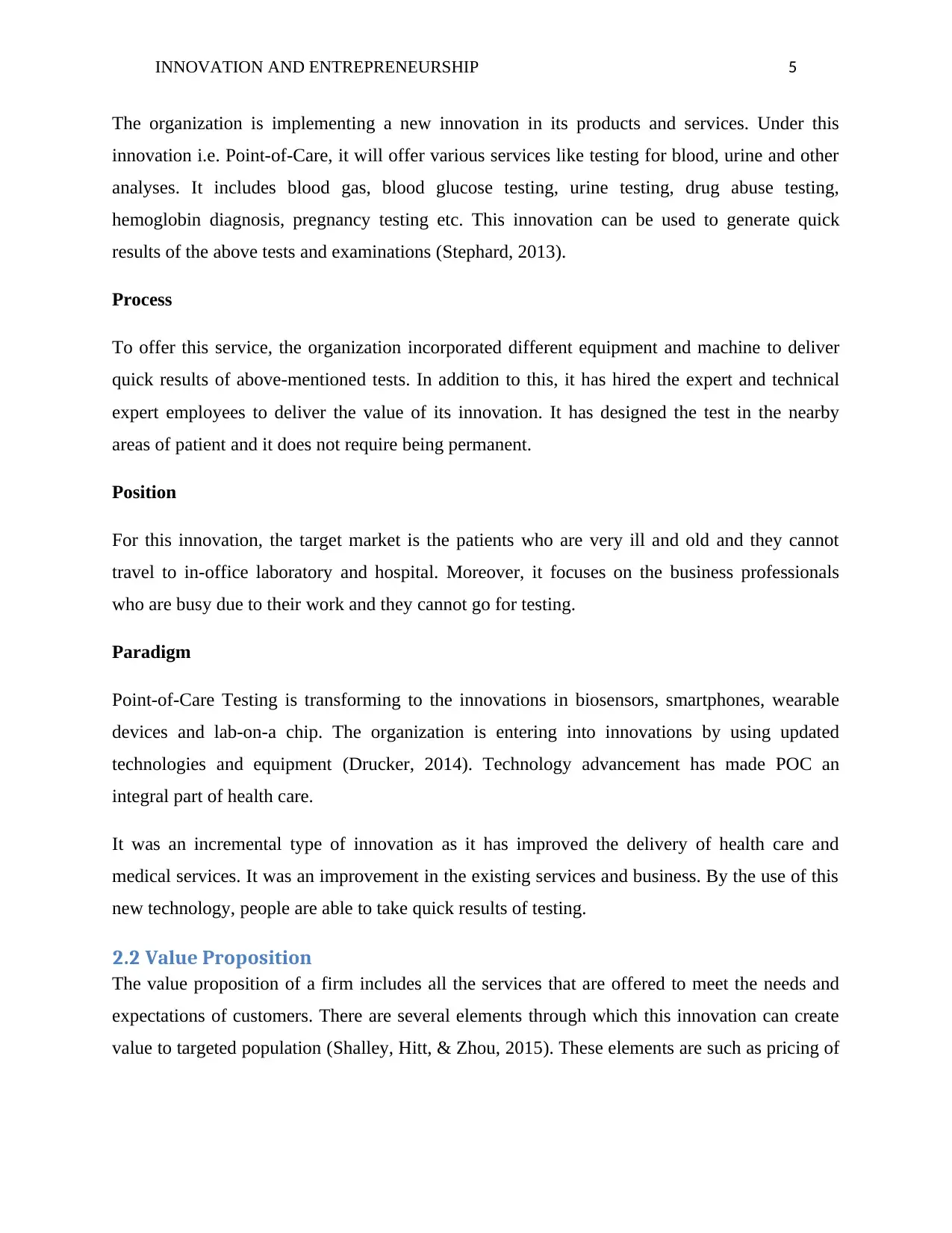
INNOVATION AND ENTREPRENEURSHIP 5
The organization is implementing a new innovation in its products and services. Under this
innovation i.e. Point-of-Care, it will offer various services like testing for blood, urine and other
analyses. It includes blood gas, blood glucose testing, urine testing, drug abuse testing,
hemoglobin diagnosis, pregnancy testing etc. This innovation can be used to generate quick
results of the above tests and examinations (Stephard, 2013).
Process
To offer this service, the organization incorporated different equipment and machine to deliver
quick results of above-mentioned tests. In addition to this, it has hired the expert and technical
expert employees to deliver the value of its innovation. It has designed the test in the nearby
areas of patient and it does not require being permanent.
Position
For this innovation, the target market is the patients who are very ill and old and they cannot
travel to in-office laboratory and hospital. Moreover, it focuses on the business professionals
who are busy due to their work and they cannot go for testing.
Paradigm
Point-of-Care Testing is transforming to the innovations in biosensors, smartphones, wearable
devices and lab-on-a chip. The organization is entering into innovations by using updated
technologies and equipment (Drucker, 2014). Technology advancement has made POC an
integral part of health care.
It was an incremental type of innovation as it has improved the delivery of health care and
medical services. It was an improvement in the existing services and business. By the use of this
new technology, people are able to take quick results of testing.
2.2 Value Proposition
The value proposition of a firm includes all the services that are offered to meet the needs and
expectations of customers. There are several elements through which this innovation can create
value to targeted population (Shalley, Hitt, & Zhou, 2015). These elements are such as pricing of
The organization is implementing a new innovation in its products and services. Under this
innovation i.e. Point-of-Care, it will offer various services like testing for blood, urine and other
analyses. It includes blood gas, blood glucose testing, urine testing, drug abuse testing,
hemoglobin diagnosis, pregnancy testing etc. This innovation can be used to generate quick
results of the above tests and examinations (Stephard, 2013).
Process
To offer this service, the organization incorporated different equipment and machine to deliver
quick results of above-mentioned tests. In addition to this, it has hired the expert and technical
expert employees to deliver the value of its innovation. It has designed the test in the nearby
areas of patient and it does not require being permanent.
Position
For this innovation, the target market is the patients who are very ill and old and they cannot
travel to in-office laboratory and hospital. Moreover, it focuses on the business professionals
who are busy due to their work and they cannot go for testing.
Paradigm
Point-of-Care Testing is transforming to the innovations in biosensors, smartphones, wearable
devices and lab-on-a chip. The organization is entering into innovations by using updated
technologies and equipment (Drucker, 2014). Technology advancement has made POC an
integral part of health care.
It was an incremental type of innovation as it has improved the delivery of health care and
medical services. It was an improvement in the existing services and business. By the use of this
new technology, people are able to take quick results of testing.
2.2 Value Proposition
The value proposition of a firm includes all the services that are offered to meet the needs and
expectations of customers. There are several elements through which this innovation can create
value to targeted population (Shalley, Hitt, & Zhou, 2015). These elements are such as pricing of
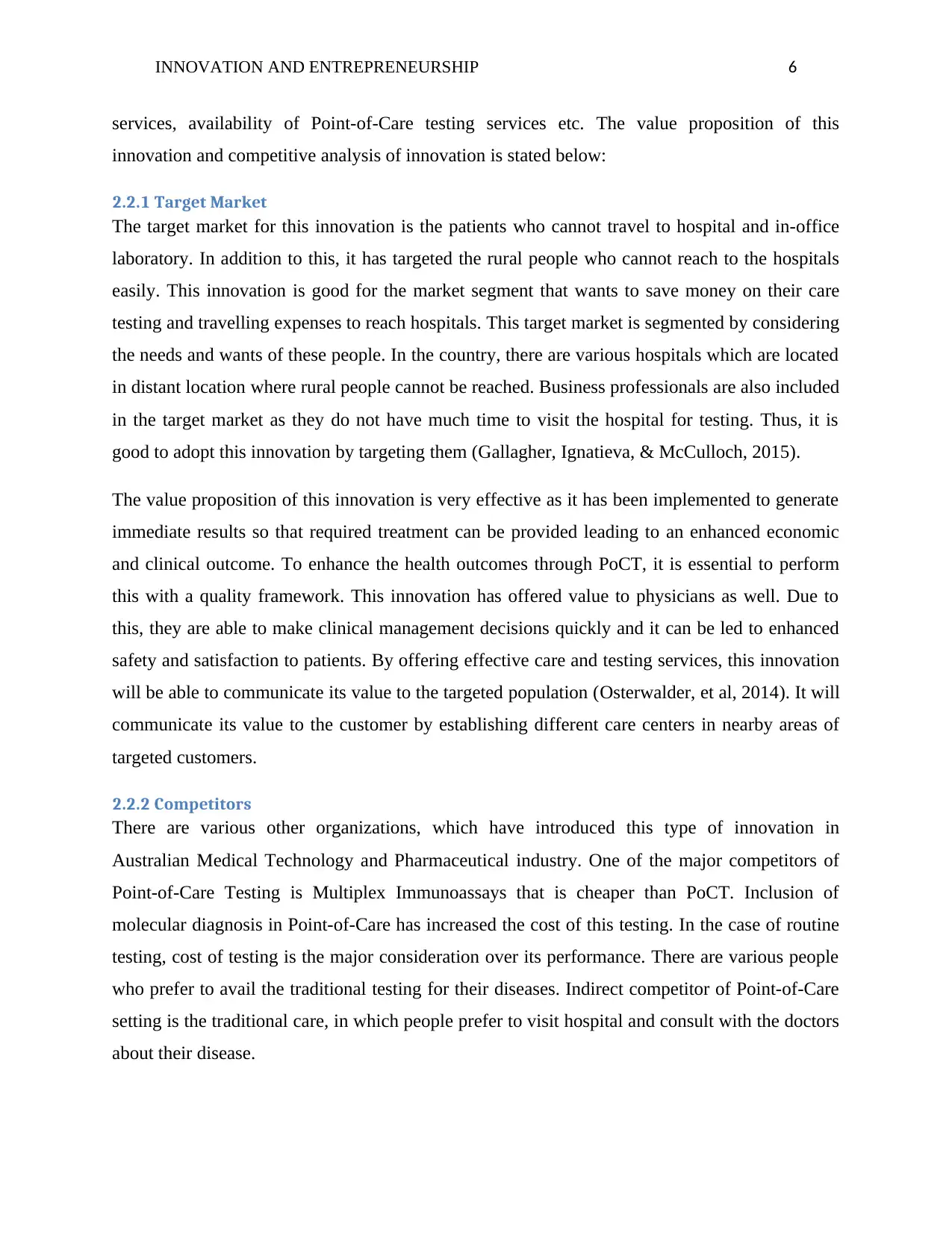
INNOVATION AND ENTREPRENEURSHIP 6
services, availability of Point-of-Care testing services etc. The value proposition of this
innovation and competitive analysis of innovation is stated below:
2.2.1 Target Market
The target market for this innovation is the patients who cannot travel to hospital and in-office
laboratory. In addition to this, it has targeted the rural people who cannot reach to the hospitals
easily. This innovation is good for the market segment that wants to save money on their care
testing and travelling expenses to reach hospitals. This target market is segmented by considering
the needs and wants of these people. In the country, there are various hospitals which are located
in distant location where rural people cannot be reached. Business professionals are also included
in the target market as they do not have much time to visit the hospital for testing. Thus, it is
good to adopt this innovation by targeting them (Gallagher, Ignatieva, & McCulloch, 2015).
The value proposition of this innovation is very effective as it has been implemented to generate
immediate results so that required treatment can be provided leading to an enhanced economic
and clinical outcome. To enhance the health outcomes through PoCT, it is essential to perform
this with a quality framework. This innovation has offered value to physicians as well. Due to
this, they are able to make clinical management decisions quickly and it can be led to enhanced
safety and satisfaction to patients. By offering effective care and testing services, this innovation
will be able to communicate its value to the targeted population (Osterwalder, et al, 2014). It will
communicate its value to the customer by establishing different care centers in nearby areas of
targeted customers.
2.2.2 Competitors
There are various other organizations, which have introduced this type of innovation in
Australian Medical Technology and Pharmaceutical industry. One of the major competitors of
Point-of-Care Testing is Multiplex Immunoassays that is cheaper than PoCT. Inclusion of
molecular diagnosis in Point-of-Care has increased the cost of this testing. In the case of routine
testing, cost of testing is the major consideration over its performance. There are various people
who prefer to avail the traditional testing for their diseases. Indirect competitor of Point-of-Care
setting is the traditional care, in which people prefer to visit hospital and consult with the doctors
about their disease.
services, availability of Point-of-Care testing services etc. The value proposition of this
innovation and competitive analysis of innovation is stated below:
2.2.1 Target Market
The target market for this innovation is the patients who cannot travel to hospital and in-office
laboratory. In addition to this, it has targeted the rural people who cannot reach to the hospitals
easily. This innovation is good for the market segment that wants to save money on their care
testing and travelling expenses to reach hospitals. This target market is segmented by considering
the needs and wants of these people. In the country, there are various hospitals which are located
in distant location where rural people cannot be reached. Business professionals are also included
in the target market as they do not have much time to visit the hospital for testing. Thus, it is
good to adopt this innovation by targeting them (Gallagher, Ignatieva, & McCulloch, 2015).
The value proposition of this innovation is very effective as it has been implemented to generate
immediate results so that required treatment can be provided leading to an enhanced economic
and clinical outcome. To enhance the health outcomes through PoCT, it is essential to perform
this with a quality framework. This innovation has offered value to physicians as well. Due to
this, they are able to make clinical management decisions quickly and it can be led to enhanced
safety and satisfaction to patients. By offering effective care and testing services, this innovation
will be able to communicate its value to the targeted population (Osterwalder, et al, 2014). It will
communicate its value to the customer by establishing different care centers in nearby areas of
targeted customers.
2.2.2 Competitors
There are various other organizations, which have introduced this type of innovation in
Australian Medical Technology and Pharmaceutical industry. One of the major competitors of
Point-of-Care Testing is Multiplex Immunoassays that is cheaper than PoCT. Inclusion of
molecular diagnosis in Point-of-Care has increased the cost of this testing. In the case of routine
testing, cost of testing is the major consideration over its performance. There are various people
who prefer to avail the traditional testing for their diseases. Indirect competitor of Point-of-Care
setting is the traditional care, in which people prefer to visit hospital and consult with the doctors
about their disease.
⊘ This is a preview!⊘
Do you want full access?
Subscribe today to unlock all pages.

Trusted by 1+ million students worldwide
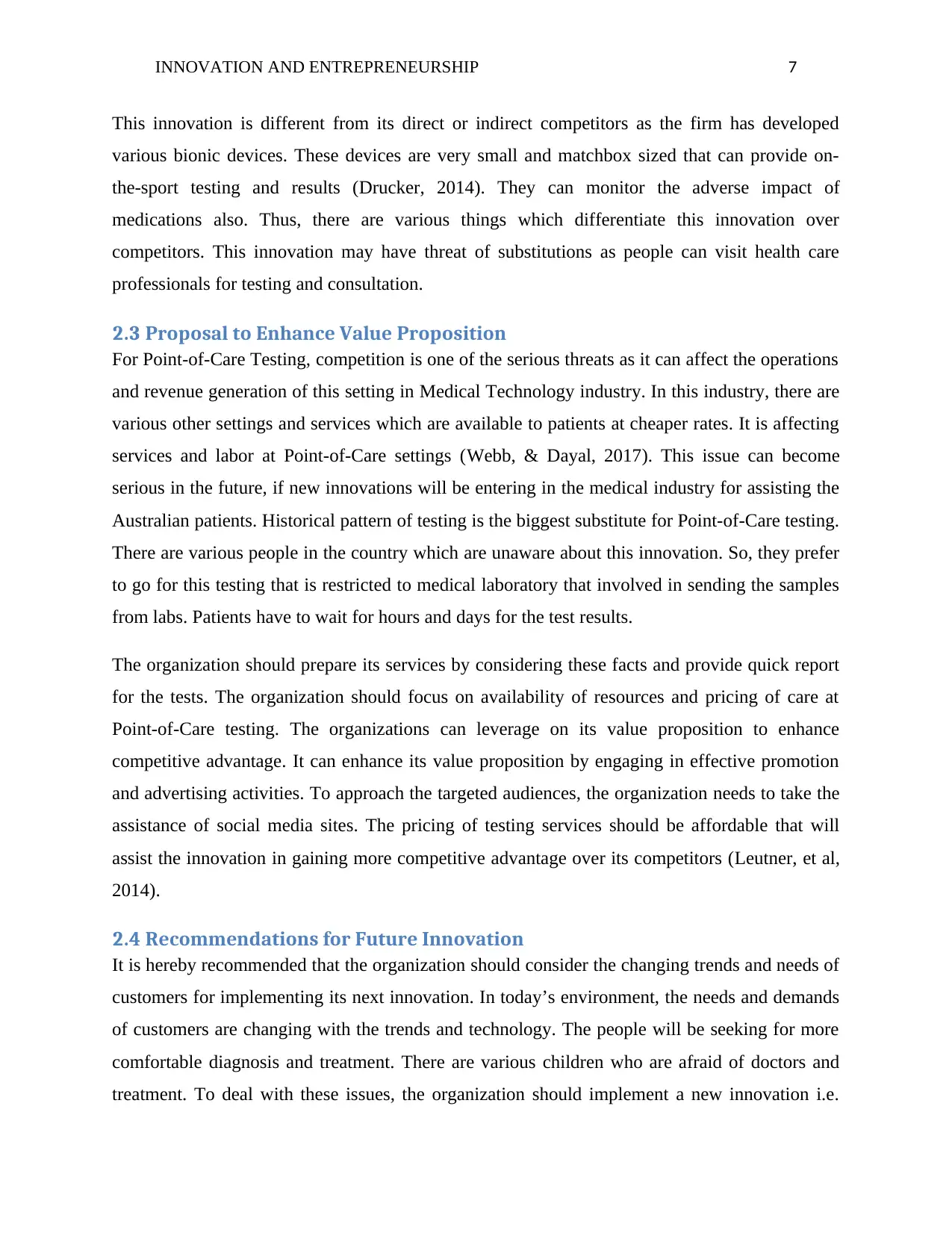
INNOVATION AND ENTREPRENEURSHIP 7
This innovation is different from its direct or indirect competitors as the firm has developed
various bionic devices. These devices are very small and matchbox sized that can provide on-
the-sport testing and results (Drucker, 2014). They can monitor the adverse impact of
medications also. Thus, there are various things which differentiate this innovation over
competitors. This innovation may have threat of substitutions as people can visit health care
professionals for testing and consultation.
2.3 Proposal to Enhance Value Proposition
For Point-of-Care Testing, competition is one of the serious threats as it can affect the operations
and revenue generation of this setting in Medical Technology industry. In this industry, there are
various other settings and services which are available to patients at cheaper rates. It is affecting
services and labor at Point-of-Care settings (Webb, & Dayal, 2017). This issue can become
serious in the future, if new innovations will be entering in the medical industry for assisting the
Australian patients. Historical pattern of testing is the biggest substitute for Point-of-Care testing.
There are various people in the country which are unaware about this innovation. So, they prefer
to go for this testing that is restricted to medical laboratory that involved in sending the samples
from labs. Patients have to wait for hours and days for the test results.
The organization should prepare its services by considering these facts and provide quick report
for the tests. The organization should focus on availability of resources and pricing of care at
Point-of-Care testing. The organizations can leverage on its value proposition to enhance
competitive advantage. It can enhance its value proposition by engaging in effective promotion
and advertising activities. To approach the targeted audiences, the organization needs to take the
assistance of social media sites. The pricing of testing services should be affordable that will
assist the innovation in gaining more competitive advantage over its competitors (Leutner, et al,
2014).
2.4 Recommendations for Future Innovation
It is hereby recommended that the organization should consider the changing trends and needs of
customers for implementing its next innovation. In today’s environment, the needs and demands
of customers are changing with the trends and technology. The people will be seeking for more
comfortable diagnosis and treatment. There are various children who are afraid of doctors and
treatment. To deal with these issues, the organization should implement a new innovation i.e.
This innovation is different from its direct or indirect competitors as the firm has developed
various bionic devices. These devices are very small and matchbox sized that can provide on-
the-sport testing and results (Drucker, 2014). They can monitor the adverse impact of
medications also. Thus, there are various things which differentiate this innovation over
competitors. This innovation may have threat of substitutions as people can visit health care
professionals for testing and consultation.
2.3 Proposal to Enhance Value Proposition
For Point-of-Care Testing, competition is one of the serious threats as it can affect the operations
and revenue generation of this setting in Medical Technology industry. In this industry, there are
various other settings and services which are available to patients at cheaper rates. It is affecting
services and labor at Point-of-Care settings (Webb, & Dayal, 2017). This issue can become
serious in the future, if new innovations will be entering in the medical industry for assisting the
Australian patients. Historical pattern of testing is the biggest substitute for Point-of-Care testing.
There are various people in the country which are unaware about this innovation. So, they prefer
to go for this testing that is restricted to medical laboratory that involved in sending the samples
from labs. Patients have to wait for hours and days for the test results.
The organization should prepare its services by considering these facts and provide quick report
for the tests. The organization should focus on availability of resources and pricing of care at
Point-of-Care testing. The organizations can leverage on its value proposition to enhance
competitive advantage. It can enhance its value proposition by engaging in effective promotion
and advertising activities. To approach the targeted audiences, the organization needs to take the
assistance of social media sites. The pricing of testing services should be affordable that will
assist the innovation in gaining more competitive advantage over its competitors (Leutner, et al,
2014).
2.4 Recommendations for Future Innovation
It is hereby recommended that the organization should consider the changing trends and needs of
customers for implementing its next innovation. In today’s environment, the needs and demands
of customers are changing with the trends and technology. The people will be seeking for more
comfortable diagnosis and treatment. There are various children who are afraid of doctors and
treatment. To deal with these issues, the organization should implement a new innovation i.e.
Paraphrase This Document
Need a fresh take? Get an instant paraphrase of this document with our AI Paraphraser
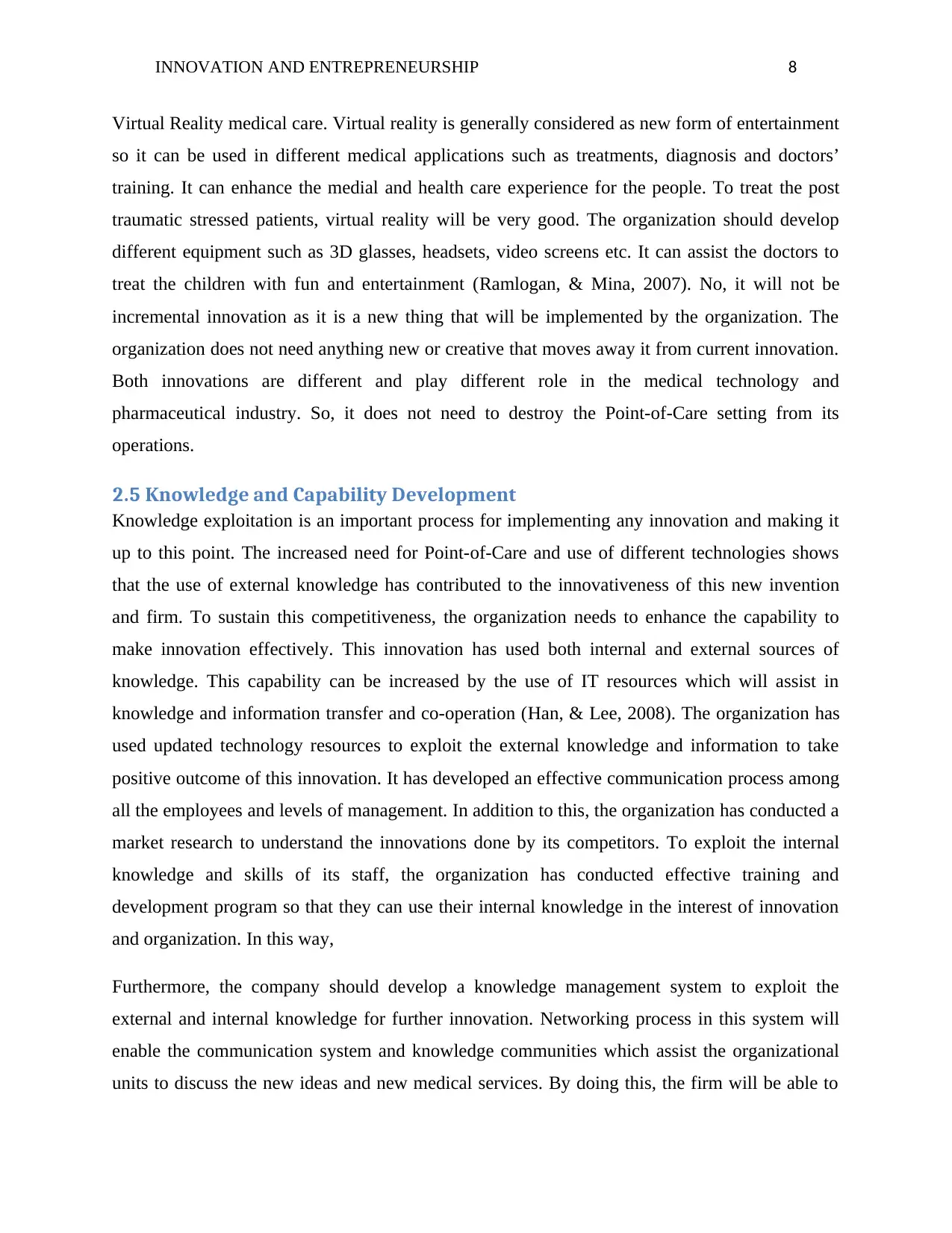
INNOVATION AND ENTREPRENEURSHIP 8
Virtual Reality medical care. Virtual reality is generally considered as new form of entertainment
so it can be used in different medical applications such as treatments, diagnosis and doctors’
training. It can enhance the medial and health care experience for the people. To treat the post
traumatic stressed patients, virtual reality will be very good. The organization should develop
different equipment such as 3D glasses, headsets, video screens etc. It can assist the doctors to
treat the children with fun and entertainment (Ramlogan, & Mina, 2007). No, it will not be
incremental innovation as it is a new thing that will be implemented by the organization. The
organization does not need anything new or creative that moves away it from current innovation.
Both innovations are different and play different role in the medical technology and
pharmaceutical industry. So, it does not need to destroy the Point-of-Care setting from its
operations.
2.5 Knowledge and Capability Development
Knowledge exploitation is an important process for implementing any innovation and making it
up to this point. The increased need for Point-of-Care and use of different technologies shows
that the use of external knowledge has contributed to the innovativeness of this new invention
and firm. To sustain this competitiveness, the organization needs to enhance the capability to
make innovation effectively. This innovation has used both internal and external sources of
knowledge. This capability can be increased by the use of IT resources which will assist in
knowledge and information transfer and co-operation (Han, & Lee, 2008). The organization has
used updated technology resources to exploit the external knowledge and information to take
positive outcome of this innovation. It has developed an effective communication process among
all the employees and levels of management. In addition to this, the organization has conducted a
market research to understand the innovations done by its competitors. To exploit the internal
knowledge and skills of its staff, the organization has conducted effective training and
development program so that they can use their internal knowledge in the interest of innovation
and organization. In this way,
Furthermore, the company should develop a knowledge management system to exploit the
external and internal knowledge for further innovation. Networking process in this system will
enable the communication system and knowledge communities which assist the organizational
units to discuss the new ideas and new medical services. By doing this, the firm will be able to
Virtual Reality medical care. Virtual reality is generally considered as new form of entertainment
so it can be used in different medical applications such as treatments, diagnosis and doctors’
training. It can enhance the medial and health care experience for the people. To treat the post
traumatic stressed patients, virtual reality will be very good. The organization should develop
different equipment such as 3D glasses, headsets, video screens etc. It can assist the doctors to
treat the children with fun and entertainment (Ramlogan, & Mina, 2007). No, it will not be
incremental innovation as it is a new thing that will be implemented by the organization. The
organization does not need anything new or creative that moves away it from current innovation.
Both innovations are different and play different role in the medical technology and
pharmaceutical industry. So, it does not need to destroy the Point-of-Care setting from its
operations.
2.5 Knowledge and Capability Development
Knowledge exploitation is an important process for implementing any innovation and making it
up to this point. The increased need for Point-of-Care and use of different technologies shows
that the use of external knowledge has contributed to the innovativeness of this new invention
and firm. To sustain this competitiveness, the organization needs to enhance the capability to
make innovation effectively. This innovation has used both internal and external sources of
knowledge. This capability can be increased by the use of IT resources which will assist in
knowledge and information transfer and co-operation (Han, & Lee, 2008). The organization has
used updated technology resources to exploit the external knowledge and information to take
positive outcome of this innovation. It has developed an effective communication process among
all the employees and levels of management. In addition to this, the organization has conducted a
market research to understand the innovations done by its competitors. To exploit the internal
knowledge and skills of its staff, the organization has conducted effective training and
development program so that they can use their internal knowledge in the interest of innovation
and organization. In this way,
Furthermore, the company should develop a knowledge management system to exploit the
external and internal knowledge for further innovation. Networking process in this system will
enable the communication system and knowledge communities which assist the organizational
units to discuss the new ideas and new medical services. By doing this, the firm will be able to
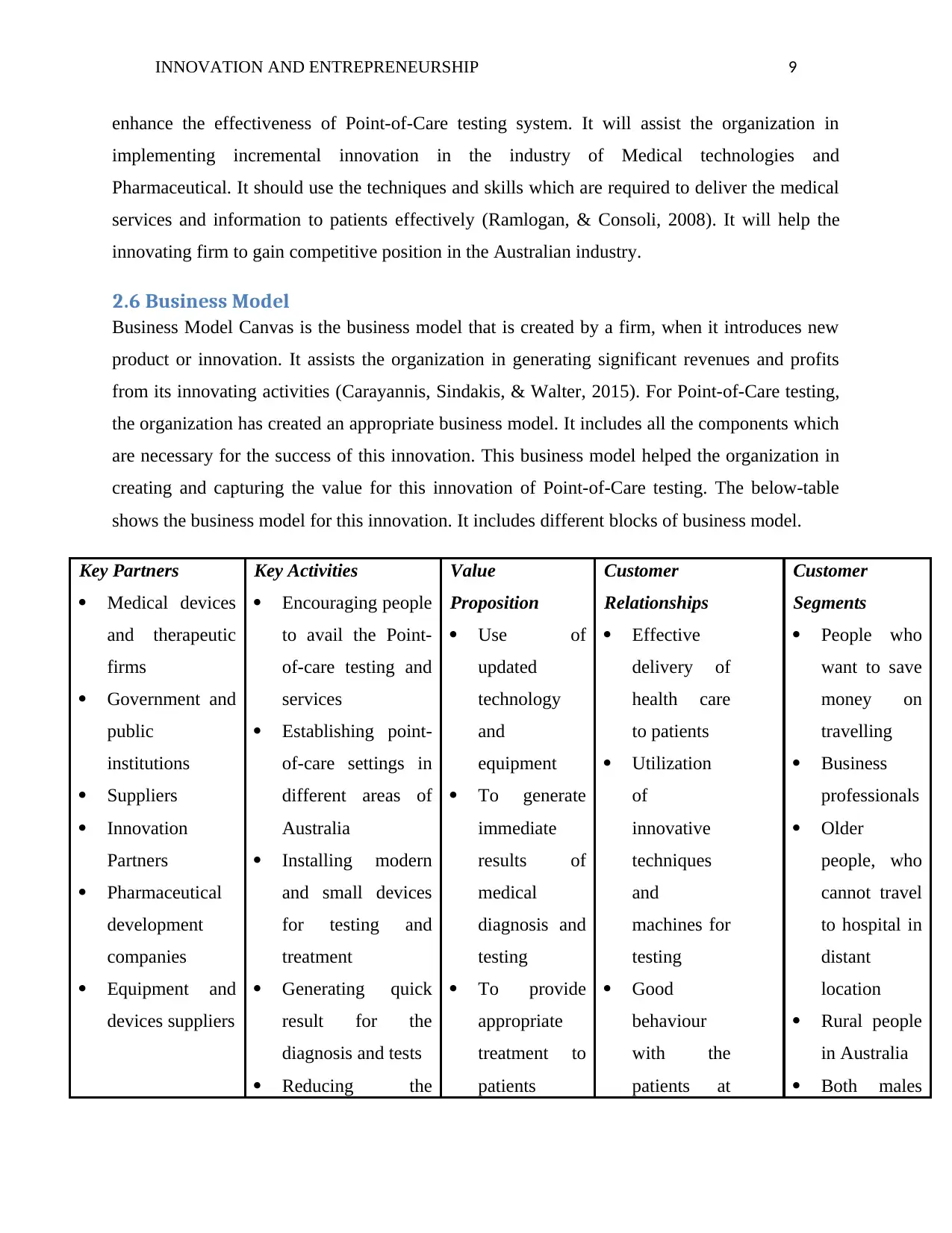
INNOVATION AND ENTREPRENEURSHIP 9
enhance the effectiveness of Point-of-Care testing system. It will assist the organization in
implementing incremental innovation in the industry of Medical technologies and
Pharmaceutical. It should use the techniques and skills which are required to deliver the medical
services and information to patients effectively (Ramlogan, & Consoli, 2008). It will help the
innovating firm to gain competitive position in the Australian industry.
2.6 Business Model
Business Model Canvas is the business model that is created by a firm, when it introduces new
product or innovation. It assists the organization in generating significant revenues and profits
from its innovating activities (Carayannis, Sindakis, & Walter, 2015). For Point-of-Care testing,
the organization has created an appropriate business model. It includes all the components which
are necessary for the success of this innovation. This business model helped the organization in
creating and capturing the value for this innovation of Point-of-Care testing. The below-table
shows the business model for this innovation. It includes different blocks of business model.
Key Partners
Medical devices
and therapeutic
firms
Government and
public
institutions
Suppliers
Innovation
Partners
Pharmaceutical
development
companies
Equipment and
devices suppliers
Key Activities
Encouraging people
to avail the Point-
of-care testing and
services
Establishing point-
of-care settings in
different areas of
Australia
Installing modern
and small devices
for testing and
treatment
Generating quick
result for the
diagnosis and tests
Reducing the
Value
Proposition
Use of
updated
technology
and
equipment
To generate
immediate
results of
medical
diagnosis and
testing
To provide
appropriate
treatment to
patients
Customer
Relationships
Effective
delivery of
health care
to patients
Utilization
of
innovative
techniques
and
machines for
testing
Good
behaviour
with the
patients at
Customer
Segments
People who
want to save
money on
travelling
Business
professionals
Older
people, who
cannot travel
to hospital in
distant
location
Rural people
in Australia
Both males
enhance the effectiveness of Point-of-Care testing system. It will assist the organization in
implementing incremental innovation in the industry of Medical technologies and
Pharmaceutical. It should use the techniques and skills which are required to deliver the medical
services and information to patients effectively (Ramlogan, & Consoli, 2008). It will help the
innovating firm to gain competitive position in the Australian industry.
2.6 Business Model
Business Model Canvas is the business model that is created by a firm, when it introduces new
product or innovation. It assists the organization in generating significant revenues and profits
from its innovating activities (Carayannis, Sindakis, & Walter, 2015). For Point-of-Care testing,
the organization has created an appropriate business model. It includes all the components which
are necessary for the success of this innovation. This business model helped the organization in
creating and capturing the value for this innovation of Point-of-Care testing. The below-table
shows the business model for this innovation. It includes different blocks of business model.
Key Partners
Medical devices
and therapeutic
firms
Government and
public
institutions
Suppliers
Innovation
Partners
Pharmaceutical
development
companies
Equipment and
devices suppliers
Key Activities
Encouraging people
to avail the Point-
of-care testing and
services
Establishing point-
of-care settings in
different areas of
Australia
Installing modern
and small devices
for testing and
treatment
Generating quick
result for the
diagnosis and tests
Reducing the
Value
Proposition
Use of
updated
technology
and
equipment
To generate
immediate
results of
medical
diagnosis and
testing
To provide
appropriate
treatment to
patients
Customer
Relationships
Effective
delivery of
health care
to patients
Utilization
of
innovative
techniques
and
machines for
testing
Good
behaviour
with the
patients at
Customer
Segments
People who
want to save
money on
travelling
Business
professionals
Older
people, who
cannot travel
to hospital in
distant
location
Rural people
in Australia
Both males
⊘ This is a preview!⊘
Do you want full access?
Subscribe today to unlock all pages.

Trusted by 1+ million students worldwide
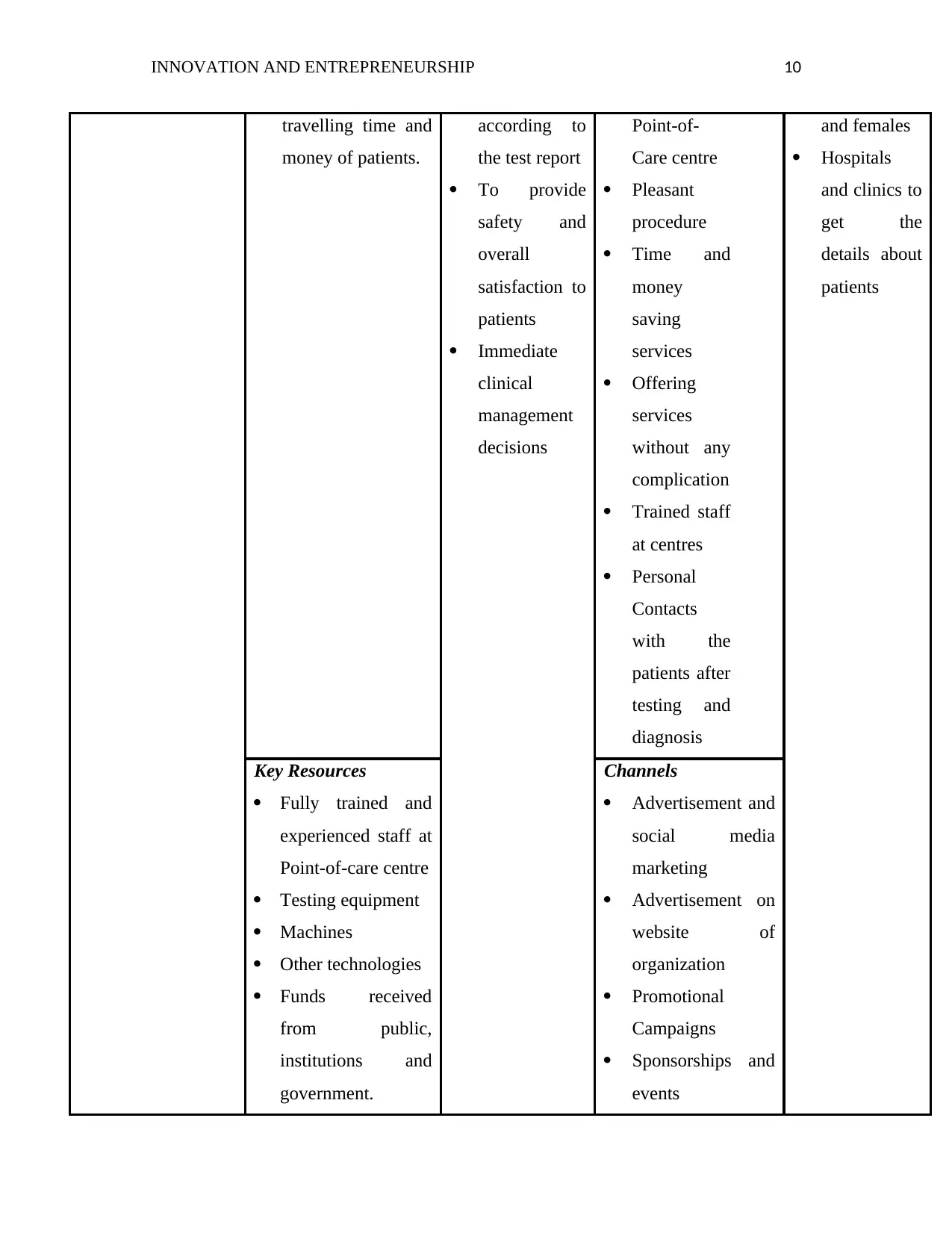
INNOVATION AND ENTREPRENEURSHIP 10
travelling time and
money of patients.
according to
the test report
To provide
safety and
overall
satisfaction to
patients
Immediate
clinical
management
decisions
Point-of-
Care centre
Pleasant
procedure
Time and
money
saving
services
Offering
services
without any
complication
Trained staff
at centres
Personal
Contacts
with the
patients after
testing and
diagnosis
and females
Hospitals
and clinics to
get the
details about
patients
Key Resources
Fully trained and
experienced staff at
Point-of-care centre
Testing equipment
Machines
Other technologies
Funds received
from public,
institutions and
government.
Channels
Advertisement and
social media
marketing
Advertisement on
website of
organization
Promotional
Campaigns
Sponsorships and
events
travelling time and
money of patients.
according to
the test report
To provide
safety and
overall
satisfaction to
patients
Immediate
clinical
management
decisions
Point-of-
Care centre
Pleasant
procedure
Time and
money
saving
services
Offering
services
without any
complication
Trained staff
at centres
Personal
Contacts
with the
patients after
testing and
diagnosis
and females
Hospitals
and clinics to
get the
details about
patients
Key Resources
Fully trained and
experienced staff at
Point-of-care centre
Testing equipment
Machines
Other technologies
Funds received
from public,
institutions and
government.
Channels
Advertisement and
social media
marketing
Advertisement on
website of
organization
Promotional
Campaigns
Sponsorships and
events
Paraphrase This Document
Need a fresh take? Get an instant paraphrase of this document with our AI Paraphraser
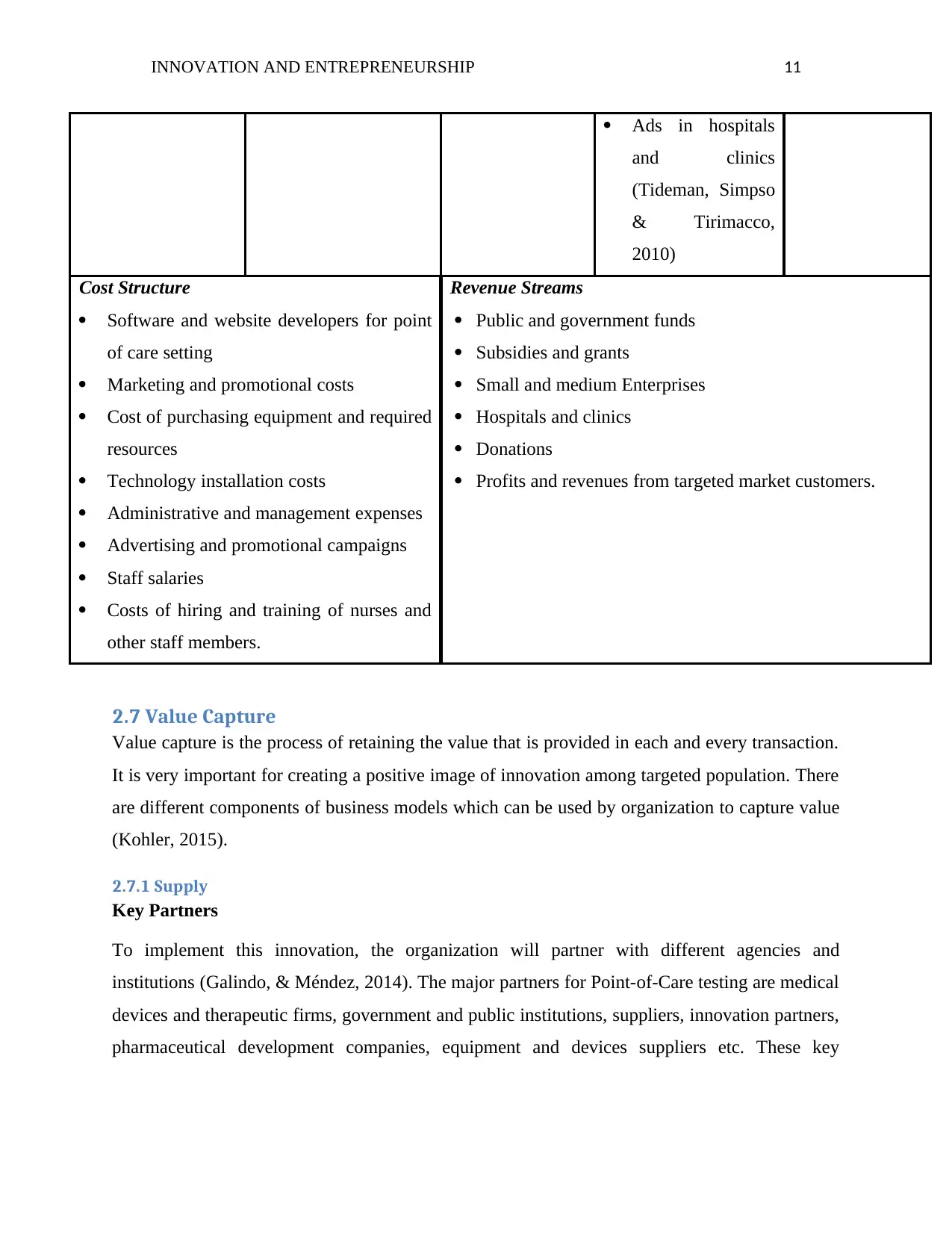
INNOVATION AND ENTREPRENEURSHIP 11
Ads in hospitals
and clinics
(Tideman, Simpso
& Tirimacco,
2010)
Cost Structure
Software and website developers for point
of care setting
Marketing and promotional costs
Cost of purchasing equipment and required
resources
Technology installation costs
Administrative and management expenses
Advertising and promotional campaigns
Staff salaries
Costs of hiring and training of nurses and
other staff members.
Revenue Streams
Public and government funds
Subsidies and grants
Small and medium Enterprises
Hospitals and clinics
Donations
Profits and revenues from targeted market customers.
2.7 Value Capture
Value capture is the process of retaining the value that is provided in each and every transaction.
It is very important for creating a positive image of innovation among targeted population. There
are different components of business models which can be used by organization to capture value
(Kohler, 2015).
2.7.1 Supply
Key Partners
To implement this innovation, the organization will partner with different agencies and
institutions (Galindo, & Méndez, 2014). The major partners for Point-of-Care testing are medical
devices and therapeutic firms, government and public institutions, suppliers, innovation partners,
pharmaceutical development companies, equipment and devices suppliers etc. These key
Ads in hospitals
and clinics
(Tideman, Simpso
& Tirimacco,
2010)
Cost Structure
Software and website developers for point
of care setting
Marketing and promotional costs
Cost of purchasing equipment and required
resources
Technology installation costs
Administrative and management expenses
Advertising and promotional campaigns
Staff salaries
Costs of hiring and training of nurses and
other staff members.
Revenue Streams
Public and government funds
Subsidies and grants
Small and medium Enterprises
Hospitals and clinics
Donations
Profits and revenues from targeted market customers.
2.7 Value Capture
Value capture is the process of retaining the value that is provided in each and every transaction.
It is very important for creating a positive image of innovation among targeted population. There
are different components of business models which can be used by organization to capture value
(Kohler, 2015).
2.7.1 Supply
Key Partners
To implement this innovation, the organization will partner with different agencies and
institutions (Galindo, & Méndez, 2014). The major partners for Point-of-Care testing are medical
devices and therapeutic firms, government and public institutions, suppliers, innovation partners,
pharmaceutical development companies, equipment and devices suppliers etc. These key
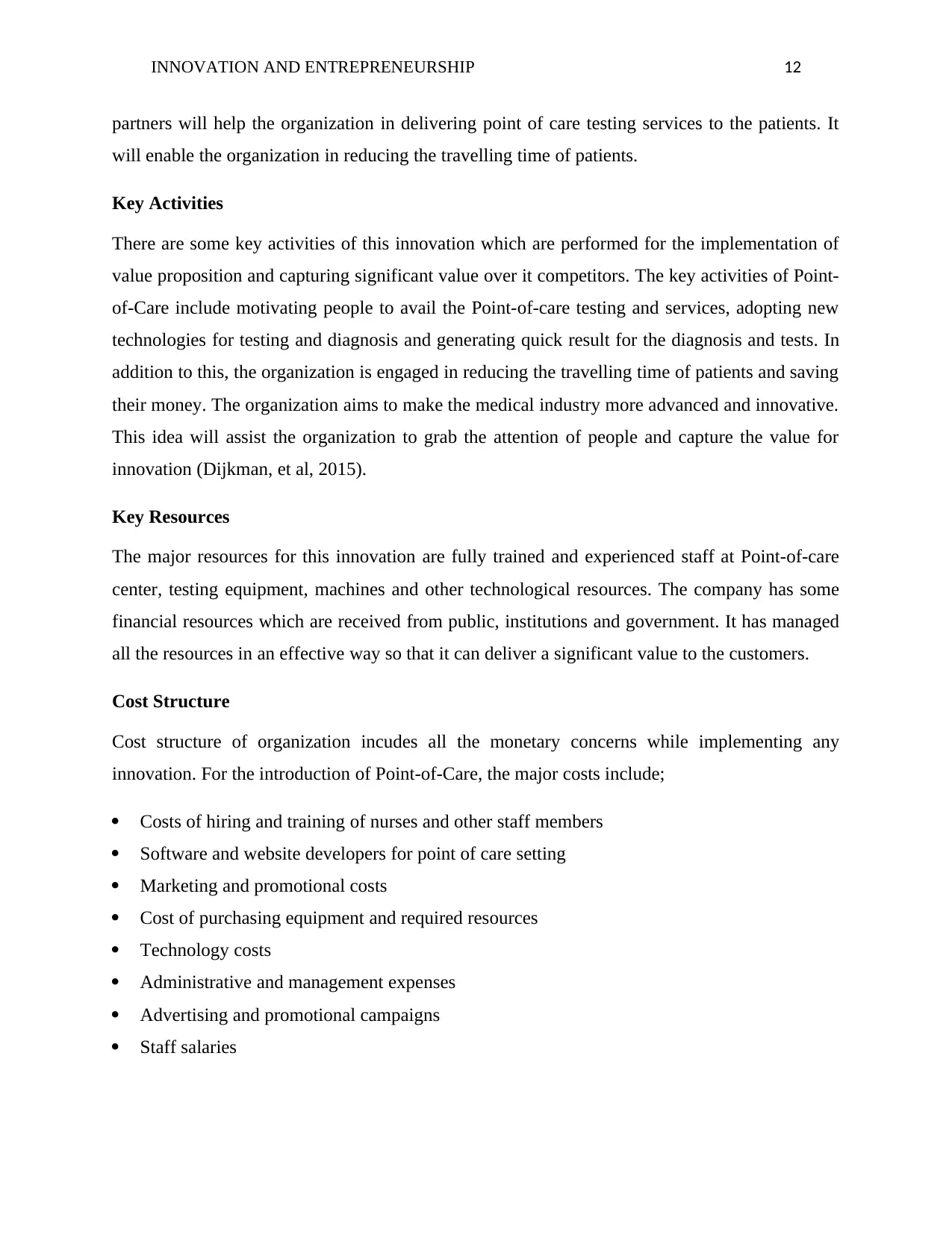
INNOVATION AND ENTREPRENEURSHIP 12
partners will help the organization in delivering point of care testing services to the patients. It
will enable the organization in reducing the travelling time of patients.
Key Activities
There are some key activities of this innovation which are performed for the implementation of
value proposition and capturing significant value over it competitors. The key activities of Point-
of-Care include motivating people to avail the Point-of-care testing and services, adopting new
technologies for testing and diagnosis and generating quick result for the diagnosis and tests. In
addition to this, the organization is engaged in reducing the travelling time of patients and saving
their money. The organization aims to make the medical industry more advanced and innovative.
This idea will assist the organization to grab the attention of people and capture the value for
innovation (Dijkman, et al, 2015).
Key Resources
The major resources for this innovation are fully trained and experienced staff at Point-of-care
center, testing equipment, machines and other technological resources. The company has some
financial resources which are received from public, institutions and government. It has managed
all the resources in an effective way so that it can deliver a significant value to the customers.
Cost Structure
Cost structure of organization incudes all the monetary concerns while implementing any
innovation. For the introduction of Point-of-Care, the major costs include;
Costs of hiring and training of nurses and other staff members
Software and website developers for point of care setting
Marketing and promotional costs
Cost of purchasing equipment and required resources
Technology costs
Administrative and management expenses
Advertising and promotional campaigns
Staff salaries
partners will help the organization in delivering point of care testing services to the patients. It
will enable the organization in reducing the travelling time of patients.
Key Activities
There are some key activities of this innovation which are performed for the implementation of
value proposition and capturing significant value over it competitors. The key activities of Point-
of-Care include motivating people to avail the Point-of-care testing and services, adopting new
technologies for testing and diagnosis and generating quick result for the diagnosis and tests. In
addition to this, the organization is engaged in reducing the travelling time of patients and saving
their money. The organization aims to make the medical industry more advanced and innovative.
This idea will assist the organization to grab the attention of people and capture the value for
innovation (Dijkman, et al, 2015).
Key Resources
The major resources for this innovation are fully trained and experienced staff at Point-of-care
center, testing equipment, machines and other technological resources. The company has some
financial resources which are received from public, institutions and government. It has managed
all the resources in an effective way so that it can deliver a significant value to the customers.
Cost Structure
Cost structure of organization incudes all the monetary concerns while implementing any
innovation. For the introduction of Point-of-Care, the major costs include;
Costs of hiring and training of nurses and other staff members
Software and website developers for point of care setting
Marketing and promotional costs
Cost of purchasing equipment and required resources
Technology costs
Administrative and management expenses
Advertising and promotional campaigns
Staff salaries
⊘ This is a preview!⊘
Do you want full access?
Subscribe today to unlock all pages.

Trusted by 1+ million students worldwide
1 out of 16
Related Documents
Your All-in-One AI-Powered Toolkit for Academic Success.
+13062052269
info@desklib.com
Available 24*7 on WhatsApp / Email
![[object Object]](/_next/static/media/star-bottom.7253800d.svg)
Unlock your academic potential
Copyright © 2020–2025 A2Z Services. All Rights Reserved. Developed and managed by ZUCOL.




